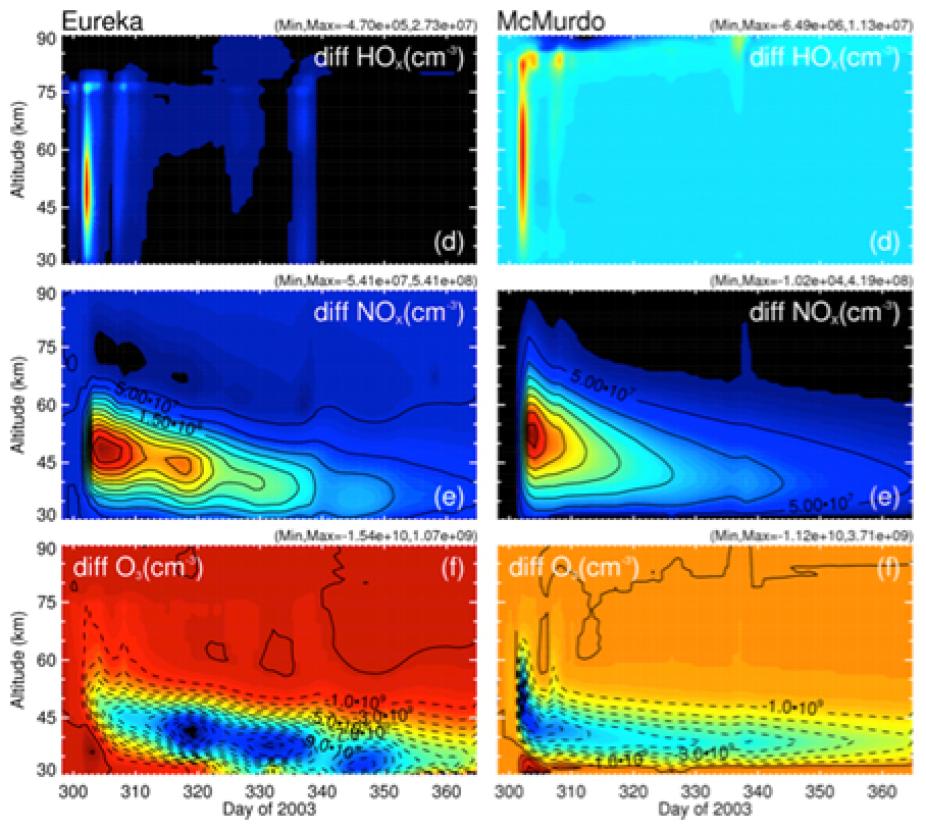Impact of Energetic Particles on the upper Atmosphere
Energetic particles, namely electrons and protons, released from the magnetosphere cover a wide range of energies from a few electron volts (eV) to hundreds of milli-electron volts (MeV). Precipitating electrons of several kilo electron volts (keV) are deposited in the 90–150 km altitude range, and they are mostly responsible for producing auroras and creating the E-region ionosphere. Though protons with energies less than 30 keV also produce auroral emission at higher altitudes, they contribute less than 20% of the total energy input in the auroral zone. More energetic electrons of a few hundred keV can penetrate to the lower thermosphere and mesosphere. Modeling studies have demonstrated that these energetic particles can significantly enhance the D-region electron density and also alternate the chemical compositions between 70 and 80 km altitudes. Solar energetic protons (SEPs), particularly those with energies >1 MeV, penetrate even deeper into the atmosphere, and their effects have been seen down to the upper stratosphere. To understand and elucidate the effects of the different energetic particles on the upper atmosphere, the Thermosphere Ionosphere Mesosphere Electrodynamics General Circulation Model (TIMEGCM), together with observations from the NOAA Polar Orbiting Environment Satellites (POES) and the Geostationary Operational Environmental Satellites (GOES), are used to delineate and understand how the various energetic particles affect the upper atmosphere during the well-known Halloween storm of October 2003.

Figure 1. Difference plots between simulations including and excluding SEPs. –(left column) difference HOX, NOX and O3 over Eureka in northern Canada and (right column) difference HOX, NOX and O3 over McMurdo in Antarctic from 25 October to 31 December 2003. The maximal and minimal values are indicated in the upper right corner of each panel.
The SEP effects on the upper atmosphere are illustrated in Figure 1, which shows the difference plots of HOX, NOX and O3 over Eureka in northern Canada and over McMurdo in Antarctic. The differences are between the TIMEGCM runs with and without the GOES-11 SEP data input while auroral precipitation is kept the same and MEPED data are excluded in the two runs. The increase in HOX by SEPs is short lived due to its short lifetime, and is concentrated between 40~60 km in the northern polar region. The vertical distribution of the SEP-produced HOX in the southern polar cap extends to a broader altitude range from 40 km up to 80 km. This hemispheric difference is largely owing to the seasonal difference between the winter northern polar cap and the summer-like southern polar cap. Though the enhanced SEPs last only a few days in duration, their impact on the upper atmosphere can be seen over several months after the storms. Precipitating SEPs cause significant increase in NOX in the altitude range of 35-70 km initially over both polar regions, which then slowly diminish while being transported downward in the northern hemisphere due to mesospheric circulation. By the end of the year, the remnant of increased NOX can still be seen in the upper stratosphere around 35-40 km in the northern polar cap. The vertical distribution of the difference NOX in the southern polar cap lies about 5 km higher than that in the northern polar cap, and the magnitude of the southern NOX change is also smaller. NOX is one of the most important constituents that catalytically destroy ozone. Indeed, significant O3 reduction is found below 55 km that persists throughout the rest of the year and even into early 2004. The difference O3 by SEPs also displays large hemispheric asymmetry, with the O3 reduction being much larger in the northern polar cap than in the southern polar cap and also the downward transport being more prominent. The hemispheric asymmetry in the NOX and O3 response shown in Figure 1 is a seasonal effect, and has been confirmed by several satellite observations during the same event.
This work was sponsored in part by the Heliophysics Guest Investigators program under NASA grant NNH09AK621, by the Living With a Star program under NASA grant NNX14AE08G, and by the U.S. Participating Investigator (USPI) Program under NASA Grant NNX12AD26G.
Source: Lu, G. (2015), Energetic and Dynamic Coupling of the Magnetosphere-Ionosphere-Thermosphere System, AGU monograph on Magnosphee-Ionosphere Coupling in the Solar System, edited by Rich Chappell, Bob Schunk, Jim Burch, Richard Thorne, and Peter Banks, in press.